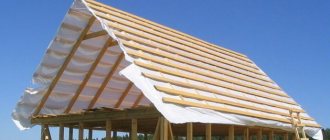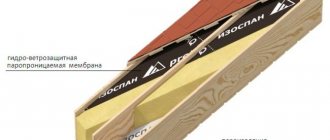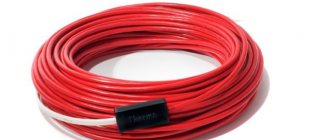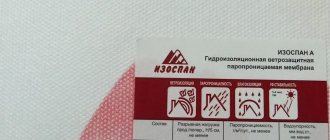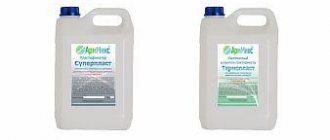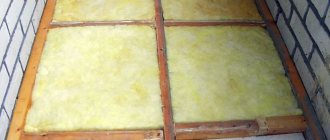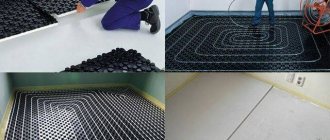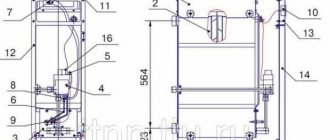Wood and humidity are incompatible things. Moisture has a negative impact on any wooden products. Even in small quantities, it gradually penetrates the structure of the tree and destroys it from the inside, activates the processes of decay, and due to increased humidity, mold and mildew appear on wooden products over time. When installing wooden floors in a house - especially if they are laid on the lower floor - you should take care of high-quality vapor barrier. A membrane material such as Izospan B has proven itself well, instructions for use for flooring in a wooden house are presented in this article.
Izospan B: instructions for use for floors in a wooden house
Izospan V, 70 sq. m.
Why is vapor barrier so important?
Vapor barrier is a series of measures that imply, when installing any building structure, the laying of special materials that protect this structure from the penetration of moisture, steam, and the formation of condensation. In general, vapor barrier is not complete protection against water, but it can protect building elements from the formation of condensation moisture in ceilings, beams and similar structures.
Vapor barrier of the floor in a wooden house
Floors in wooden houses are often laid directly on the top layer of soil, but this is a complete violation of installation technology. Such negligence can lead to fairly rapid destruction of wooden foundations. Wood under the influence of excess dampness quickly becomes unusable - moisture penetrates the structure of the material and begins to destroy it from the inside, rotting processes develop, and pockets of mold and mildew form on the surface.
Example of mold on wooden surfaces
At the same time, not only pure water becomes dangerous for wooden structures, but also its vapors that arise during the evaporation of liquids - for example, when the soil under the floor dries out, in the kitchen during cooking, while mopping or doing laundry. Indicators of atmospheric pressure and temperature in the environment are quite changeable, and it is because of these changes that condensation begins to form on the surface of wood (and indeed any materials).
Attention! Floors in any building, and especially in a residential building, are exposed to the negative effects of dampness both above and below - from the ground and from inside the house. It is especially important to protect the foundation in a wooden house, that is, in a low-rise building.
If you take care of installing a vapor barrier, the process of working with which is not at all complicated, then you can avoid a lot of negative consequences. At the same time, the advantage of such materials is that they are capable of allowing air to pass through, and there is no need to be afraid that the house will not “breathe”.
Vapor barrier for floors in a private house
Advice from professionals
To avoid “excruciating pain” for wasted effort and money, professionals advise adhering to the following simple rules:
- when starting to implement a construction project, carefully read its graphic part and explanatory note;
- do not hesitate to ask questions to the designers, foreman and workers at all stages of work, be meticulous until the situation is completely clarified, remembering that they will go to the next projects, and you will live here;
- do not oppress the contractor with petty quibbles, but strictly control each stage of the work, sign acceptance certificates only after all comments have been eliminated.
The given “professional advice” is universal in nature and applies not only to laying vapor barriers on the floor, but also to all types and stages of construction work.
Izospan for flooring in a wooden house
The membrane material Izospan will help to protect floor elements in the house made of wood. It has a special structure that will help protect any wooden structures from exposure to steam and moisture.
Types of material
Izospan in general is a special material, which is a membrane that reliably protects various structures from the effects of external environmental factors - wind, steam, precipitation, moisture, including condensation. Thanks to it, the tree will be reliably protected from the premature onset of rotting processes.
Table of material characteristics Izospan
Technical characteristics of Izospan:
- it is not afraid of exposure to ultraviolet rays and copes well with their reflection;
- durable, copes well with some type of mechanical loads, even if it is exposed regularly;
- has an antioxidant layer;
- moisture-resistant material that retains the ability to resist moisture throughout the entire period of use;
- not afraid of exposure to positive or negative temperatures;
- can be used in any type of structure.
Vapor barrier film Izospan V
On a note! Certain types of Izospan have not only vapor barrier properties. They can act as a heat-retaining material - usually this Izospan has a foil layer.
Izospan is not a completely waterproof material. On the contrary, it helps the steam escape, due to which condensation does not accumulate on the material or wooden surfaces covered by it.
Izospan B - sample
Areas of application of the material
Izospan membrane can be used in various areas of construction:
- for arranging an insulated roof , it is laid between the roof covering and the insulation (Izospan grade A, AM is usually used), as well as between the insulation and rafters (Izospan B);
- for the construction of walls (two types of Izospan are also used - grade A, AM are laid between the counter-batten and the insulation closer to the outer part of the wall, and B - in front of the interior finishing of the walls);
- to create floors (Izospan V is laid before installing the finished floor).
Types of vapor barrier materials
Izospan is used for the construction of not only wooden houses, but also those with concrete elements. For example, it is laid during the construction of uninsulated roofs that have slopes or are flat (Izospan C, D). It is also used for additional protection of concrete floors (Izospan S), laid directly on the concrete base.
On a note! To protect wooden floors from steam, you can use absolutely any type of Izospan.
Areas of application of Izospan
Talitsa. Types of Izospan material.
| Material class | a brief description of |
| Izospan A | Widely used in various construction fields. Provides effective protection of any internal structures from moisture and condensation. Izospan A, on the one hand, allows you to protect the structure from the effects of wind, and on the other, from the penetration of steam. Most often used in local installation work. Installation of vapor barrier material is carried out on the outside of the building structure, that is, its action is aimed at protecting insulation and other elements from exposure to atmospheric phenomena. Very durable material. |
| Izospan B | It has increased protection against steam due to the special structure of the membrane. On one side, the material is fleecy (this is where it is laid directly towards the insulating material), and on the other, it is smooth to the touch (the side is directed towards the finished floor). One of the most popular membrane films. |
| Izospan S | It is characterized by high strength and reliability compared to other types of Izospan. For production, polypropylene fabric is used, which allows the material to be endowed with excellent protective properties. |
| Izospan D | It has a comprehensive effect on the protection of various building structures. Has the maximum level of resistance to ultraviolet radiation. Universal material. |
Polypropylene film
This is a stronger and more durable material, which is easy to install and resistant to atmospheric factors. Modern polypropylene films have an additional anti-condensation layer of cellulose and viscose, which absorbs and retains large volumes of moisture. Due to the good absorbency of the material, condensation does not form drops, and the absorbed moisture gradually dries out.
There are polypropylene films on sale that do not have an anti-condensation layer. When they are used, condensation forms on the surface located on the insulation side, so they are not recommended for use on wooden floors.
What is Izospan B?
Among all the variations of Izospan, the most popular is the brand designated by the letter B. It is this type that is most often used during the installation of wood flooring in the construction of private sector houses. The material is made on the basis of polypropylene, which is characterized by excellent resistance to various mechanical damage.
Izospan B
Izospan B is translucent, has two layers that are tactilely different from each other. One of them is smooth to the touch, the other has a small pile. The main task of the material is to protect wooden structures from exposure to moisture and the formation of condensation, which negatively affects the materials used for the finishing of premises.
Attention! Izospan B is not recommended for external use. This material is used only inside buildings.
Izospan B is used to create floors in rooms with high levels of air humidity, to lay laminate or parquet, and to protect insulating material laid when installing roofs. Can be used for laying during installation of interfloor ceilings, as well as ceilings located in the attic or on the ground floor of a building.
Izospan installation process
Technical features of Izospan B:
- the transverse tensile load is 104 N/5 cm, and the longitudinal tensile load is 128 N/5 cm;
- density – 72 g/m2;
- vapor permeability – 22.5 g/m2/day;
- water resistance – up to 1000 mm water. Art.;
- dimensions – 1.4x50 m;
- ability to withstand temperatures ranging from -60 to +80 degrees;
- Resistance to UV rays reaches 3 months (direct exposure).
Izospan
The advantages that allowed the material to become popular:
- long service life;
- high strength;
- the ability to significantly increase the service life of other building materials, including insulation;
- protection of materials from moisture, mold and mildew;
- ease of installation;
- safety in terms of impact on human health and the environment.
Izospan B can be called one of the best materials in terms of price-quality ratio. This membrane is also a fireproof material - it is not prone to fire, but, on the contrary, goes out quite quickly, even if it catches fire.
Izospan B is fireproof
Prices for vapor barrier "Izospan V"
isospan b
General installation rules
In order for the material to function as expected, it is important to carefully study the instructions before starting to work with it. Otherwise, it is easy to make mistakes during installation and, thus, Izospan B will be of no use, and the owner of the house will think that he has thrown money away.
In order for the material to work as expected, the following rules must be observed during operation:
- The material must be fastened from top to bottom when working on inclined or vertical structures;
- individual sheets of material are attached with an overlap of at least 15 cm;
- the joints between the canvases must be glued with special tape;
- Izospan B is laid in such a way that its fleecy side is turned towards the insulation;
- Izospan can be secured using small bars, a stapler, or clamping strips.
Izospan in floor vapor barrier
Required tools and materials
To work with Izospan B, you need to ensure that you have a certain number of tools:
- scissors - for cutting material;
- tape measure or ruler - for applying dimensions and measuring material;
- fastening elements - nails, self-tapping screws, both options are used with galvanization;
- adhesive tape used in construction - for gluing the joints of individual sections of material;
- stapler - will allow you to quickly attach Izospan V to the base (used only for wooden bases);
- slats, metal profiles - they can also be used to fasten the material, but the need for their use will depend only on the type of final finishing of the room.
What is needed to work with Izospan
Preparation for installation of a water vapor barrier layer
Installation of Izospan V involves a number of preparatory works. In general, the floor pie in a wooden house is the following design:
- rough base;
- wooden logs;
- thermal insulation layer;
- waterproofing;
- finishing floor;
- finishing coating.
You should not violate the technology for installing a wooden floor, because otherwise the structure will turn out to be unreliable. The entire pie should ideally rest on brick or concrete supports, with a small ventilated area between the soil and the wood floor. The vapor barrier should be installed immediately during the construction of the house; there is no need to postpone this stage “for later”.
Vapor barrier will reliably protect against moisture and condensation
Preparations before laying the vapor barrier membrane are as follows. To begin with, all wooden parts of the floor pie are treated with a special protective compound, which will allow the tree to acquire immunity to rot and fungus for the longest possible period. Particular attention should be paid to wooden joists and the rough floor, on which the membrane material will be laid.
On a note! If the vapor barrier layer is planned to be installed in an already finished building, then before doing so it is recommended to replace all the old elements with new ones. This is a replacement of insulation and worn elements of the subfloor.
Connecting tape (adhesive tape) Izospan FL
Briefly about the main thing
If you don’t know how to install a vapor barrier on the floor of a wooden house correctly, you can find out within a couple of years that it has begun to rot, and the insulation has gotten wet and stopped working. The main rule is not to use impenetrable films that are prone to condensation accumulation for vapor barrier of wooden structures. The material must retain excess moisture and gradually evaporate it. Special films and membranes have these properties, some of which are intended for indoor use, others for outdoor use.
During installation, it is important to take into account that such materials are double-sided and to lay them correctly
Source
Carrying out work on laying a vapor barrier membrane
Laying Izospan B does not require any special skills or knowledge. Even a novice master can handle the material.
Step 1. The required amount of Izospan V material is purchased. It will be equal to the size of the floor area, to the value of which a certain amount of material required for the overlap is added. This is approximately 15-20% of the total area of Izospan V.
First you need to purchase suitable material
Step 2. A number of preparatory works are carried out in advance, as mentioned above. Next, insulation is laid between the joists.
Laying insulation between joists
Step 3. The vapor barrier material begins to be laid on the outermost joists from one of the walls. It is best to start installation from the wall farthest relative to the exit. The material is laid in such a way as to cover the joists well. The rough side of the material should face the insulation.
Example of laying vapor barrier material
Step 4. To attach Izospan B, it is best to use a stapler. The material is targeted to the joists.
Fastening the material with a stapler
Step 5. The next piece of material is laid overlapping the previously laid and secured one. The overlap width is at least 15 cm.
The material is laid with an overlap
Advice! There should be a small gap between the insulation and Izospan - 4-5 cm. It is necessary for ventilation of the materials.
Step 6. Two Izospan B sheets in the overlap area are glued together using adhesive tape. This will allow you to achieve a certain tightness of the vapor barrier layer.
Adhesive tape is used to glue the canvases together
Step 7. It is recommended to additionally protect the lower part of the floor structure with a vapor and waterproofing layer of Izospan D material. It is also fastened using a construction stapler.
Izospan D
Step 8. It is recommended to glue the joints of Izospan B to wooden structures with special Izospan ML tape.
An example of using Izospan ML tape
On a note! In case of mechanical damage to the material web, it must be repaired. To do this, you can use special glue or Izospan tape.
Technologies
The above floating floor protection materials are applied in different ways. Therefore, depending on the construction budget, you should choose the right technology.
Deposition
Since in 75% of cases roll waterproofing materials are traditionally used, fusing technology is used most often:
- the dried concrete base is dust-free and impregnated with bitumen primer;
- pieces of Bikrost, Technonikol, roofing felt, Steklodroizol or any other rolled material are cut in advance and laid on the floor along the ground;
- the lower bitumen layer is heated by a burner torch, a piece is fused onto the concrete base, the edges are placed on the base or foundation to the height of the screed;
- the following pieces are fused with an overlap of 15 - 20 cm.
Fusing rolled insulation onto the concrete base.
Pasting
Rolled materials, polymer films and membranes can be glued to hot or cold bitumen, epoxy or polymer mastics. Some materials have their own adhesive layer, which reduces labor costs, but increases the cost of flooring on the ground, since they are more expensive than conventional rolls.
Pasting is carried out in 1 - 2 layers, depending on the level of soil in the area and the material of the underlying floor layer on the ground:
- sand is a technogenic layer in which capillary absorption of soil moisture is possible;
- There is no such effect in crushed stone, but the material is more expensive than sand and is more difficult to compact manually.
To reduce the cost of building a floor on the ground instead of concrete, the following methods are used:
- the surface of the compacted crushed stone is leveled with moistened and compacted sand, the thickness of the layer should be at least twice the coarse crushed stone fraction (for example, 8 cm for the 20/40 fraction);
- the crushed stone base is spilled with cement laitance, which binds and levels the surface, preventing the absorption of a similar concrete product when pouring the floor itself on the ground.
Penetrating mixtures
Volumetric waterproofing is carried out in several different ways:
The first technology is more appropriate when repairing a floor on the ground to improve its waterproofing characteristics. The second method allows you to avoid pouring concrete when making a floor on the ground.
Thus, to isolate a floor over the ground from soil moisture, you can choose any of the above methods, taking into account soil conditions, the design of the floor pie and the available budget.
